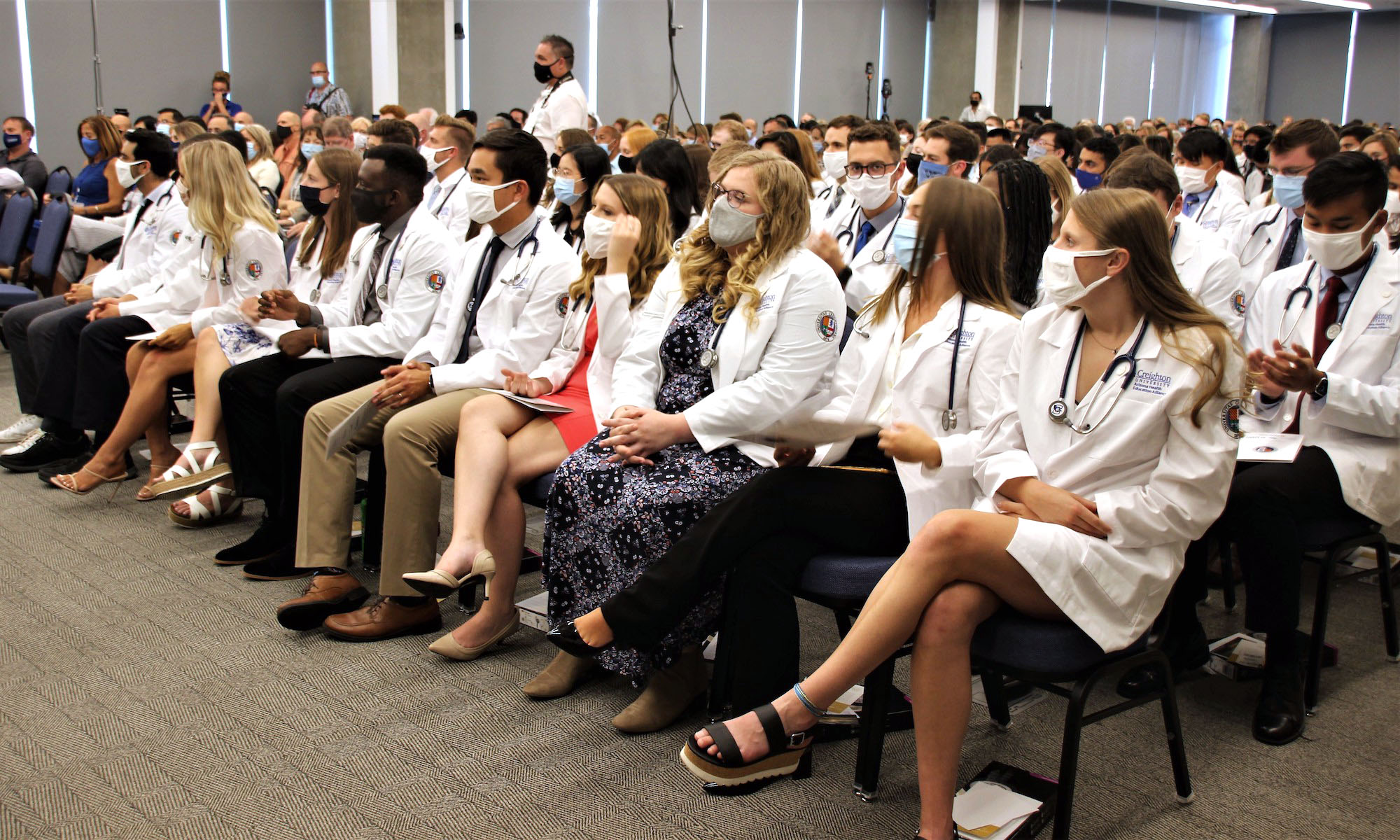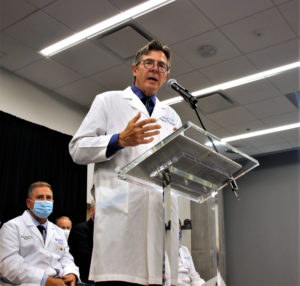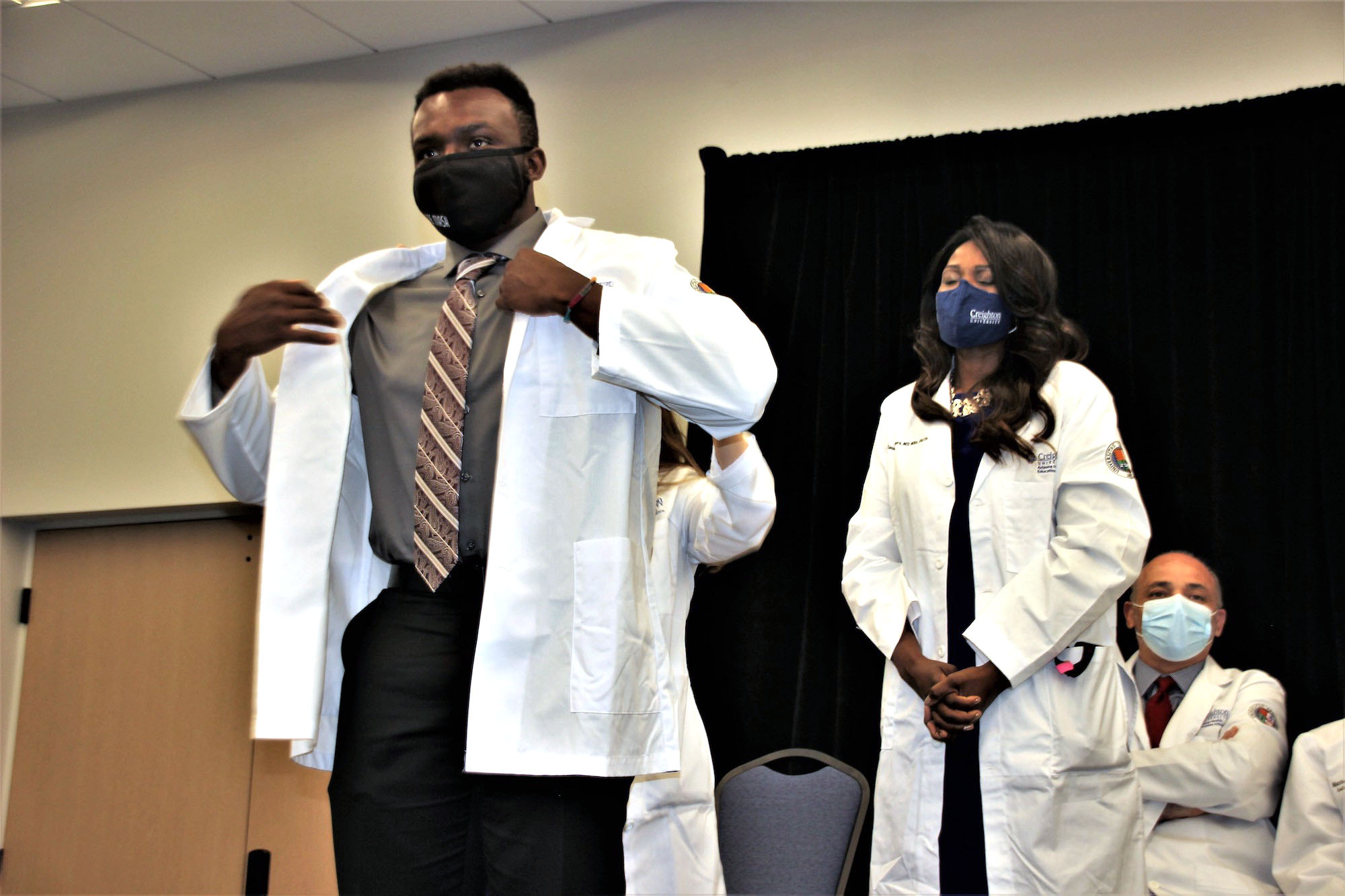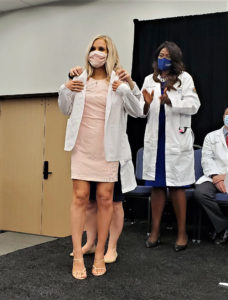
PHOENIX — The first group of four-year students at Creighton University’s new School of Medicine in Phoenix has formally begun studies to enter a profession that desperately needs them in Arizona and the Southwest.
One hundred young men and women, many joined by family and friends, took part in the Jesuit Catholic university’s White Coat Ceremony July 29 at its newly opened $100 million downtown Health Sciences campus. An additional 130 first-year students attended a similar ceremony at the School of Medicine’s main campus in Omaha, Neb., July 30 — giving Creighton a total of 230 new four-year medical students scheduled to graduate in 2025.
“Congratulations,” Dr. Robert Dunlay, Creighton School of Medicine dean, told the gathering inside the Doris S. Norton Ballroom in Phoenix.

Creighton University Medical School Dean Dr. Robert Dunlay delivers remarks to the Phoenix regional campus’ Class of 2025 as Arizona Regional Dean Dr. Randy Richardson listens during the school’s White Coat Ceremony at its brand new $100 million downtown Health Sciences campus July 29, 2021. (Jeff Grant/CATHOLIC SUN)
“God has given you this wonderful gift of a sacred calling of medicine. Before you were even born, God knew you would arrive at this moment,” he said. “Our goal is to form you for a lifetime of spiritual, emotional, and professional growth.”
Fr. Kevin Dilworth, S.J., the School of Medicine’s Phoenix regional chaplain, asked for God’s protection and guidance for the future doctors.
“May you hold, with gentle hands, the bodies and the spirits of those for whom you care. May the beauty of the soul, the strength of the spirit, the wholeness of being lead you, inspire you, and let you know your own beauty of soul, strength of spirit and wholeness of being. May you know that as you care for others God cares for you, sees you and holds you tenderly,” Fr. Dilworth prayed.
Dr. Nicole Piemonte, the Phoenix assistant dean for Student Affairs, cast the future doctors’ role in their patients’ lives as threefold.
“You are a healer, a critical thinker and a compassionate presence… embarking not only on a career but a calling…one of the most meaningful in this life,” Dr. Piemonte told the group, which includes 23 Arizonans. Others come from 22 other states and three foreign countries — Japan, Mexico, and Taiwan.
The students come with distinguished résumés. Beyond stellar grade-point averages and academic excellence, there was recognition for service and extracurricular accomplishments.
A total of 7,086 students applied to Creighton’s two medical school campuses, according to Dr. Dunlay. While most seek entrance to more than one school, a number said Creighton was their first choice.

“Medicine has always interested me,” said Oluwatosin Babarinde, 23, of Peoria. Babarinde said he finally decided on his career while a junior at nearby Brophy College Preparatory.
“I have fallen in love with (medicine) over the years and I am so grateful I am in this position now,” he said, smiling next to his mother, Tinuola, who moved to the United States in the mid-1990s from Nigeria.
Fellow student Cerys Arnold, also 23, of Chandler, made her decision much earlier, according to her mother, Alison.
“She was 7 years old and said, ‘I want to be a doctor.’” Alison Arnold recalled after the ceremony.
“I remember walking into a hospital and was so inspired,” Cerys said. “I have felt inspired every other time I have been in a hospital. I am really grateful to be here. I am a little nervous, but I am excited.”
“She worked so hard to get here,” her mother added. “She got to where she always wanted to be, and she is going to be able to follow her dream and her passion.”

The students, one by one, walked onstage, where a Creighton official helped them put on their white coats. Each then received a stethoscope and had his or her hands blessed by Fr. Dilworth.
Once investment of the coats was complete, the students recited Creighton’s Student Physicians Oath, a modified version of the centuries-old Hippocratic Oath. Attributed to the ancient Greek physician Hippocrates, the oath has been adopted as a guide of conduct by the medical profession throughout history and is still used at many medical schools. Its essence is that physicians will treat the sick as healers and do no harm in the process. Many schools have modified the oath to include vows to respect teachers and colleagues and to reflect their mission and principles. Creighton’s oath states in part:
“My colleagues will be my brothers and sisters and by instruction and example, we will impart a knowledge of the art to those who wish to learn it…
I will maintain the utmost respect for human life and the dignity of my fellow person. I will not use my knowledge contrary to the laws of humanity…
May God grant me the wisdom and compassion to study this art.”
Dr. Dunlay urged students to start each day with a deep sense of gratitude to God and end it with a few minutes of quiet reflection.
“Review things that went well during the day and things that didn’t go very well and think about how, if the situation occurs next time, you are going to use your strengths to hope for a different outcome. Business studies show people who practice personal reflection daily are more successful than others. It is also very Jesuitical: Daily reflection is something St. Ignatius (founder of the Society of Jesuits) advocated.”
Dr. Dunlay told the students their experiences would range from the joyful to the heartbreaking and encouraged them to lean on each other for support and seek out faculty for guidance.
“You are now part of the Creighton family, and as such should assist one another. All of us face trials in our lives. Our struggles help us develop and maintain a sense of humility. Always remember, we are the hands of God at work in the world, we are not gods.”
He also urged them to pursue excellence as leaders.
“We expect you to step in and not be on the sidelines in addressing important issues of our day, such as racism, poverty and other things that lead to health care disparities. If there is one thing this pandemic has brought into focus, it is that this country has a lot of issues with health care disparities.”
More medical professionals needed in Arizona
The class’s arrival and Creighton’s new campus come at a vital time for Arizona’s medical field.
“The need for another school of medicine here is huge,” said Dr. Randy Richardson, dean of the Phoenix school, after the ceremony. “There is a huge shortage of physicians — primary care doctors, and really in all the health sciences — nursing for sure.
“Even for the population versus the number of medical students, (these) are relatively small classes. Mayo (Clinic) has 50 students per year, University of Arizona, I think, is up to 100. A metropolitan area of this size usually has hundreds and hundreds of medical students — Chicago, Philadelphia, or New York — they have 800-900 per year. We have about 200-250.”
Dr. Richardson said the students will be formed well for their health care mission.
Technology will add to the abundance of information they will take in, but the practical, hands-on experience will be what really integrates them into the profession, he explained.
“The new lecture hall upstairs is not stadium seating, it is tables — with about eight seats per table for 120 students. They receive cases, and study and discuss them together. That’s active learning. We’re all moving in that direction.”
One example of how students will learn, engage in service and help address social issues related to medicine is through a collaboration between Creighton and two Catholic-based entities. Earlier this year, the university, the Society of St. Vincent de Paul, and the Virginia G. Piper Trust launched an initiative to increase access to care in the Diocese of Phoenix’s underserved community. Creighton students are playing a key role in that effort, with third- and fourth-year students rotating into the clinic where the parties are working with hospitals throughout the Valley to steer the needy away from emergency rooms for basic care and into the hands of primary care physicians.






